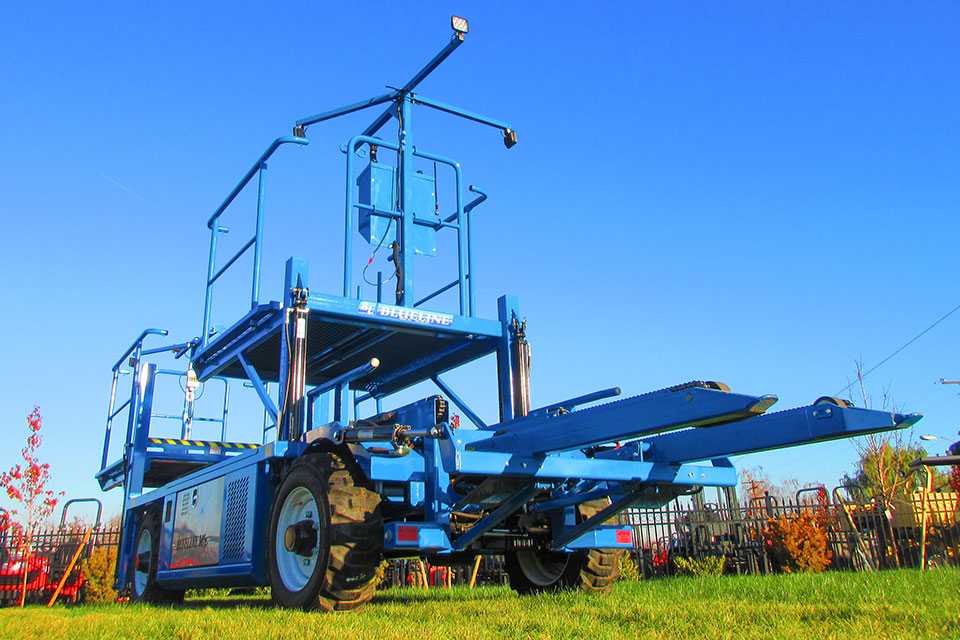Equipment Makers Power up To Reduce Labor Issues on the Farm

Blueline’s latest labor-saving device, the OPH100N Narrow Orchard Harvesting Platform, has an ultra-sonic auto steering system that eliminates the need for a full-time driver and has zero impact bin drop to maintain top fruit quality.
Photo courtesy of Blueline Manufacturing and Equipment
It’s no secret that labor — or rather its increasing scarcity — is one of fruit growers’ biggest problems and has been for many years. Manufacturers of products for tree thinning, pruning, and training are closely attuned to growers’ needs, so when surveyed, it’s no surprise labor was tops.
“I believe the biggest need growers have for 2021 is any equipment that replaces or enhances labor,” Gregg Marrs, the owner of Blueline Manufacturing and Equipment in Yakima, WA says. “Labor is becoming the No. 1 issue that can affect profitability.”
Labor is especially a concern these days because of the COVID-19 pandemic, notes Armando Leon, National Sales Manager – Agriculture, Corona, in Corona, CA. “Due to labor shortages and COVID-19, what growers are looking for is equipment that requires less ‘human user’ and less COVID-19 exposure,” he says, “which means equipment or power tools which are faster.”
Recognizing this, Leon says Corona is currently in the testing stage for more power tools, but in the meantime offers a wide range, from handheld to 6.2 feet long.
TRENDS
Growers interested in smaller pruning products should be aware of another pandemic-related factor, according to Ryan Amberg, the U.S. representative for FELCO, who is based in Geneva, NY. “FELCO has seen a huge demand surge following COVID-19, as more people improve their residential spaces and take up hobbies like gardening,” he says. “This puts excessive strain on our Swiss production of products. I would recommend growers plan ahead on their tool needs for this year and to buy early to assure their stocking needs are met.”
Like Leon, Amberg says growers should consider making the move to power-assisted tools for reducing labor and fatigue saving. “FELCO Power Blade series is our new generation of electronic pruning tools to simplify the job for growers,” he says. “Power pruners allow for decreased labor costs and decreased stress injuries from pruning.”
At the other end of equipment spectrum, Blueline offers five different types of self-propelled, self-steering orchard work platforms that can save on labor, Marrs says. Some are designed as work platforms and harvesting; some are only designed to replace ladders and set the working pace in tasks such as pruning, thinning, summer pruning, and trellis repair. These units have proven return on investment of 18 to 24 months, depending on orchard size,
he says.
One feature that may be new to a lot of growers, is Blueline has a machine that removes leaves using compressed, pulsating air prior to harvest to enhance coloring of the fruit. “This machine can pay for itself in one season,” Marrs says. “To do this job by hand was costing from $500 to $1,000 per acre.”
IT’S ALL ABOUT THE TREES
Growers interested in mechanization must think that way from the beginning, says Marrs. “I think growers need to consider mechanization when they are choosing a trellis design and training their trees. The limbs need to be trained in a horizontal plane and a uniform angle,” he says. “The canopy needs to be designed and managed in a way that will lend itself to mechanization in the future.”
Leon says that no matter what, growers need to have a plan. “Pruning your orchards extends the life of your trees and produces better quality fruits,” he says. “Orchard-shaping helps in the harvest every year.”
Taking such care of orchards may seem obvious, but Leon says it’s clearly not the case for all growers. “Some growers are skipping pruning, thinning, and training to save money every other year,” he says, “but they are exposing their trees to plagues and less fruit per acre.”
Marrs says growers tempted to skip pruning, thinning, and training because of time constraints should know they should accomplish those tasks much more quickly utilizing self-propelled work platforms.
“We have done many time studies and the average savings for all three of those jobs is 40% to 60% depending on tree structure and row width,” he says.
GOING FORWARD
As for what challenges growers might be encountering going forward, Leon cites the labor shortage and COVID-19 but adds a third that is all too familiar to Western readers – drought. “Those are the three biggest threats facing agriculture in the near future,” he says. “Discipline from the general population will help with COVID-19, automation will help with the labor shortage, and nature will help with the drought. We can only control a few concerns but not all.”
Marrs says that going forward, reducing labor is going to be even more critical and will definitely include more mechanization and attendant new technology such as self-driving tractors or more environmentally safe spraying with targeting technologies that only spray those areas of the orchard that have pests. Big changes are coming to farm labor, Marrs forecasts.
“I see the job of working on these farms as becoming one that is more permanent employment and not so seasonal. Farms will invest more into training their workers and work hard to retain those workers. I see those jobs becoming more like a factory worker and less like a field worker,” he says. “Most of these technologies currently exist, but growers tend not to change unless there’s a strong force pushing them. That may be regulatory, financial, environmental, or shortages of a stable labor force. I can be sure of one thing, change is coming!”









